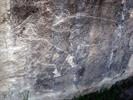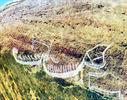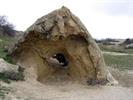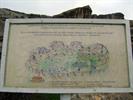The most likely origin for Jean's version of the Sharamudoi boats is in Azerbaijan, on the ancient shores of the highly expanded Caspian Sea. At that time, (10 000 - 8000 years ago) the greatly expanded Caspian and Black Sea were joined by a wide strait.
Since the area is today very flat, apart from the low hills which rise from the plains and on which the petroglyphs have been carved, it is likely that the shores would have provided an ideal area for the growth of huge areas of reeds, ideal for boat building.
At a site dated to around 5000 - 8000 years BC, at a place called Gobustan, there are paintings or etchings (petroglyphs) of what appear to be long boats in the style of the Viking ships of more recent times. Thor Heyerdahl is convinced that people from the area went to Scandinavia in about 100 AD and took their boat building skills with them, and transmuted them into the viking boats we know from digs in Northern Europe.
Carvings of reed boats at Gobustan that attracted Norwegian explorer Thor Heyerdahl to visit the site.
Discovery of Gobustan
The petroglyphs of Gobustan were not discovered by an archeological expedition. In fact, their revelation came about quite by accident. In the 1930s, work was going on there in a stone quarry. The area is full of huge boulders and rock formations. One of the quarry workers noticed some unusual carvings on the rocks. The more the rocks were cut out, the more the paintings could be seen. (Before they had been hidden from view inside a huge pile of boulders.) Even more paintings were found inside what appeared to be man-made caves. Work at the quarry soon stopped so that the paintings could be examined more carefully.
In 1939, archeologist Isaak Jafarzade began the first archeological investigation of the petroglyphs at Gobustan. Between 1940 to 1965, teams identified and documented approximately 3,500 individual rock paintings on 750 rocks. The most ancient petroglyphs have been identified as belonging to the 12-8th century B.C. However, it is assumed that life existed here even earlier and that Gobustan was one of the cradles of civilization. This research was published in a book entitled "Gobustan" in 1973.
In the ancient caves of Gobustan which date back at least 5,000 years, cave drawings depict two different kinds of boats that were used for early navigation. Heyerdahl is convinced that people living in the area now known as Azerbaijan settled in Scandinavia around 100 AD. Gobustan is located about 30 miles southwest of Baku.
If you're planning a trip to Azerbaijan you may be interested ▶ Azerbaijan highlights - For those who prefer to go unbeaten path, to explore less visited places and check national charisma of this small country in Southern Caucasus on the edge of Europe.









